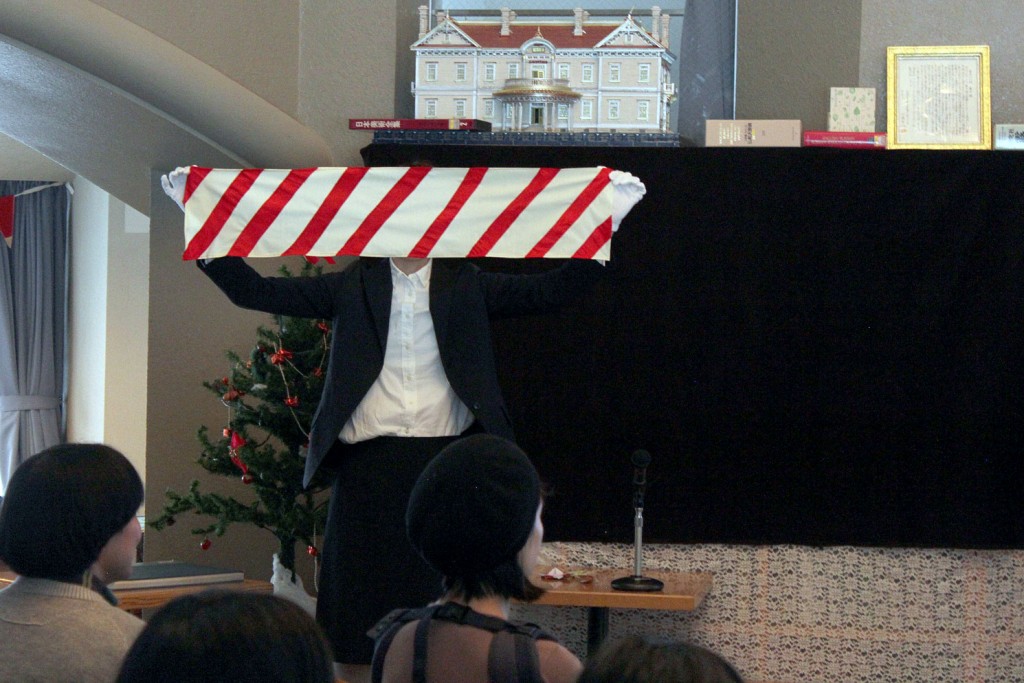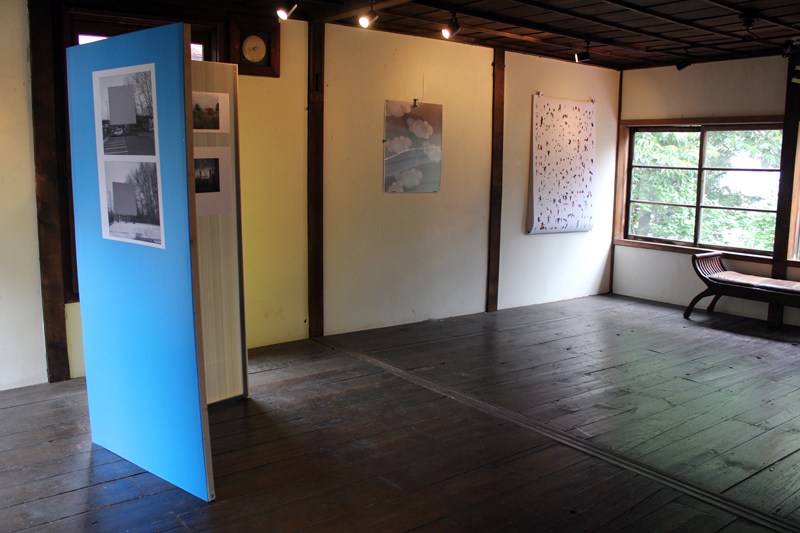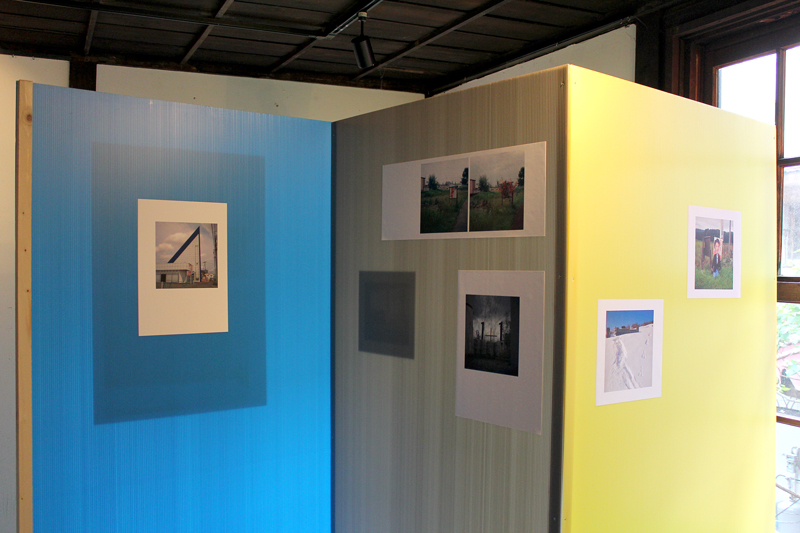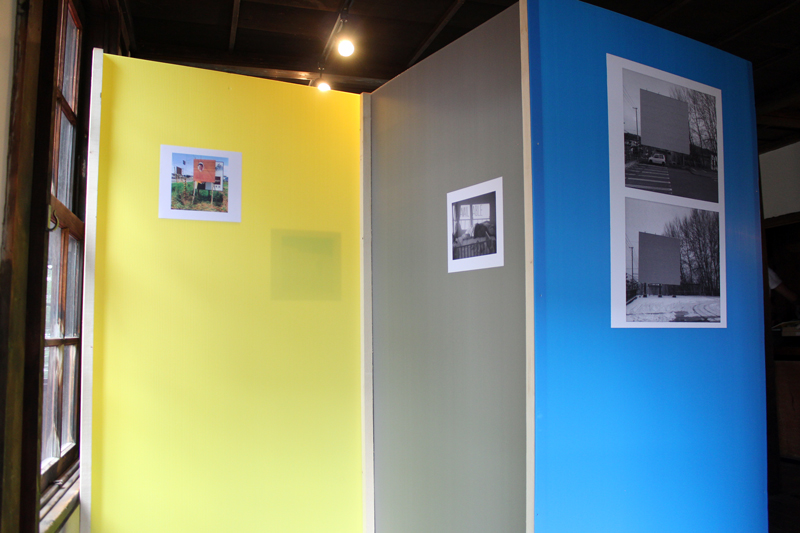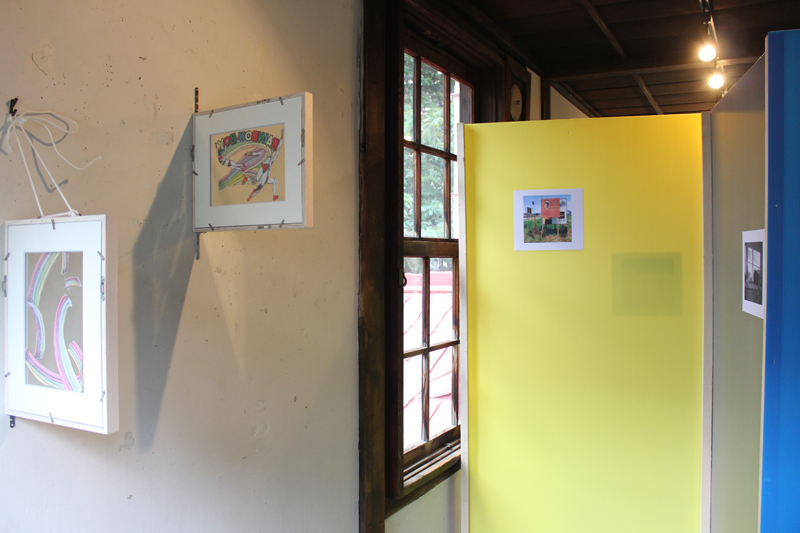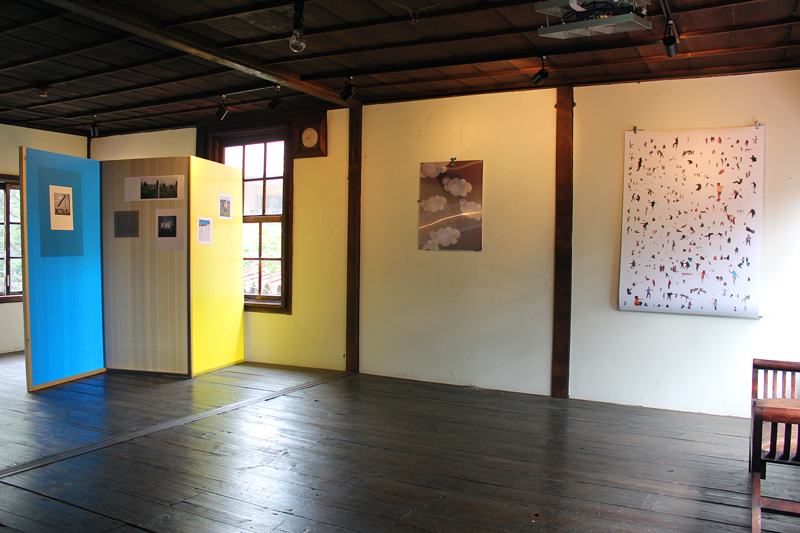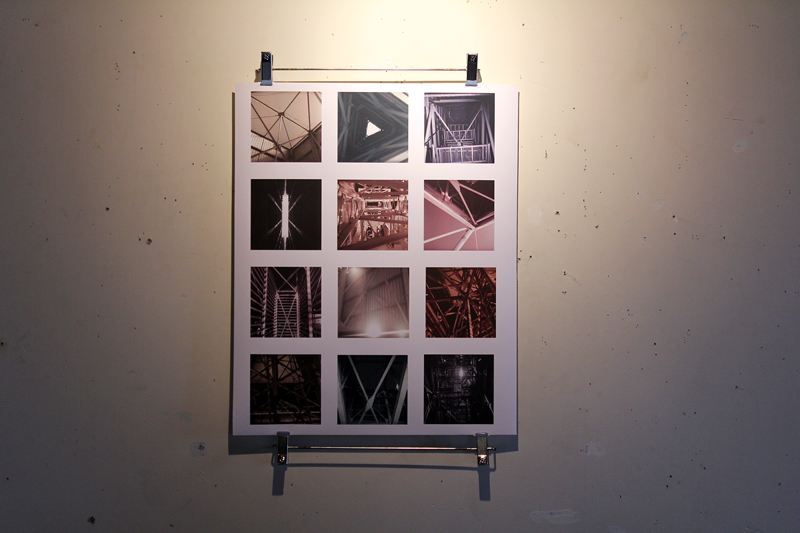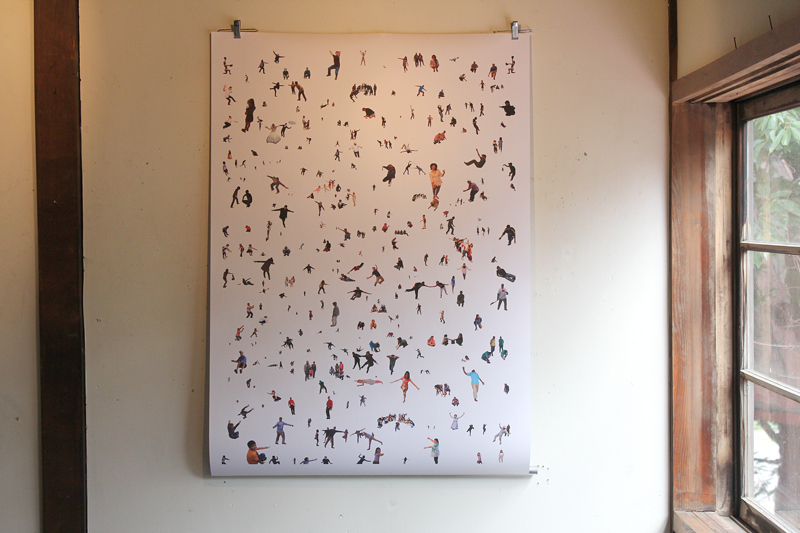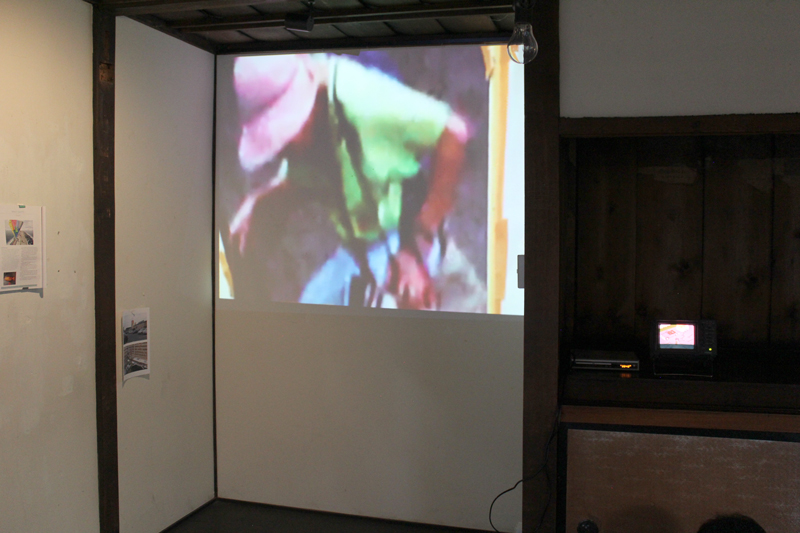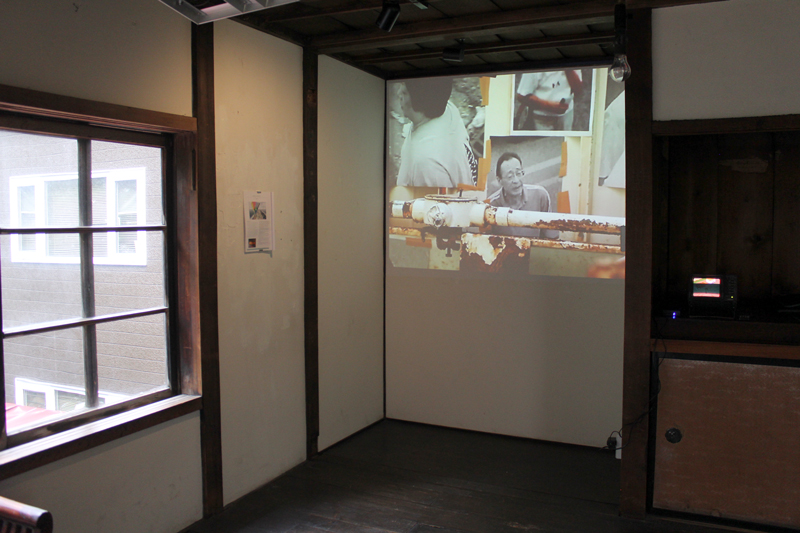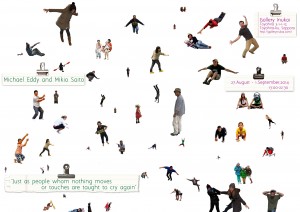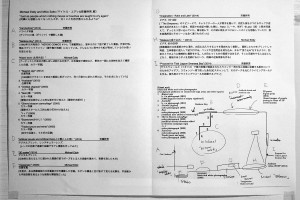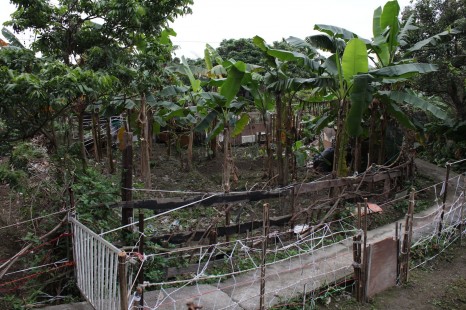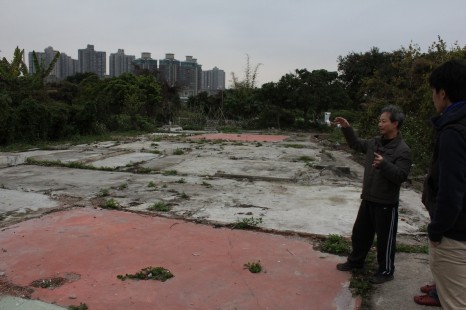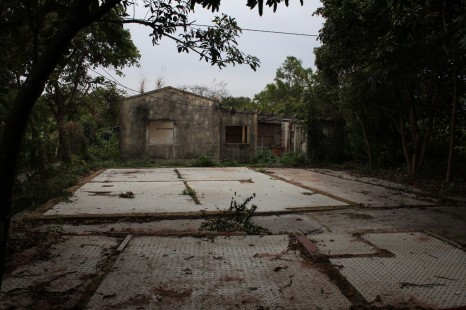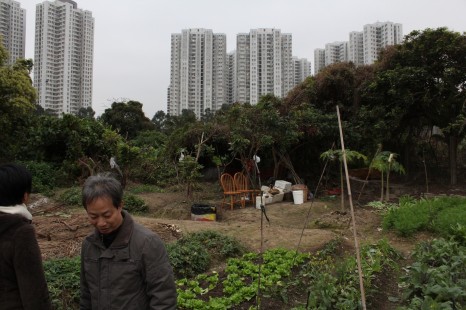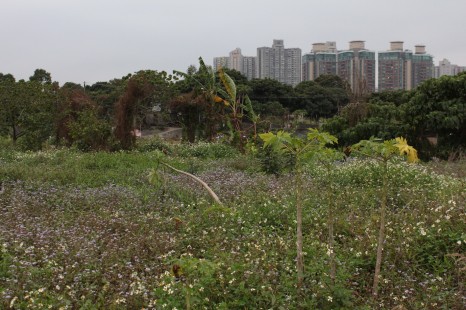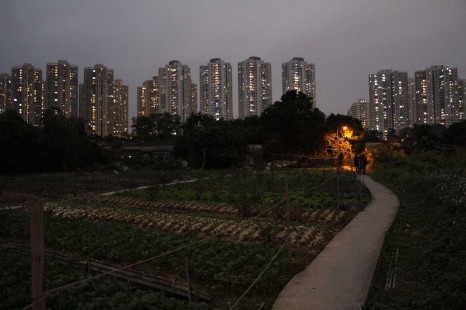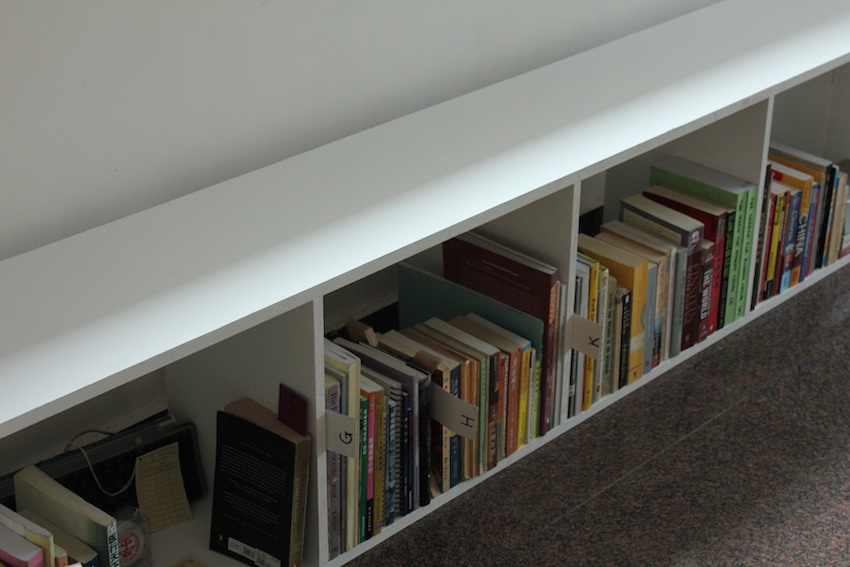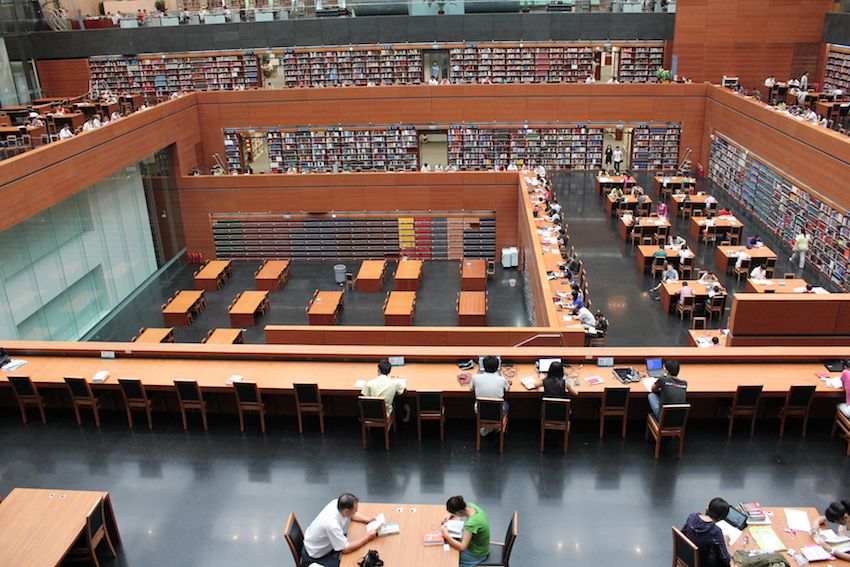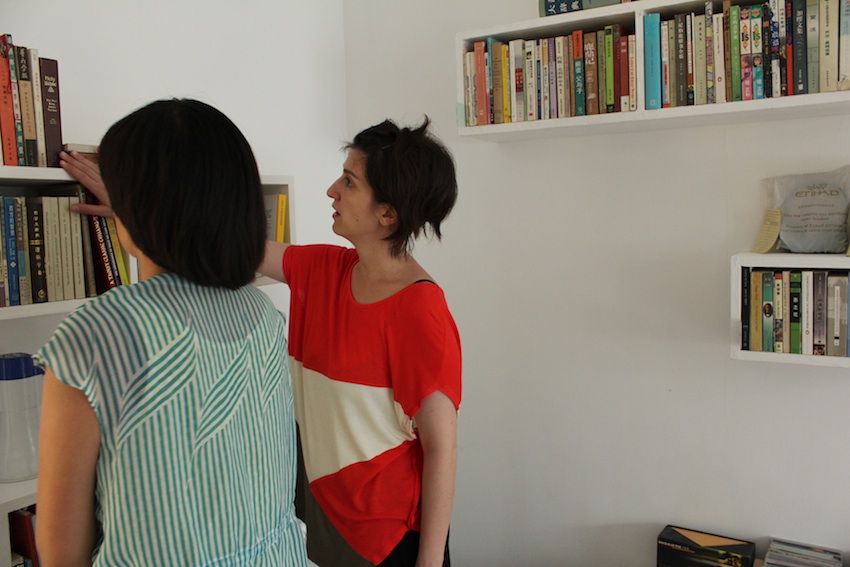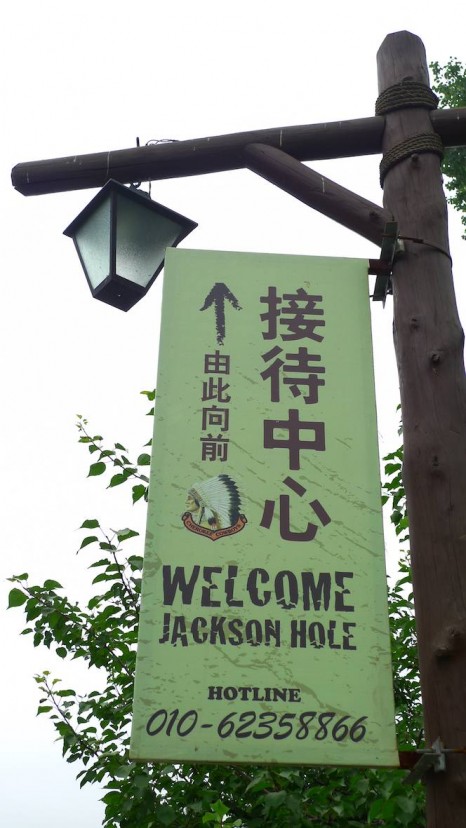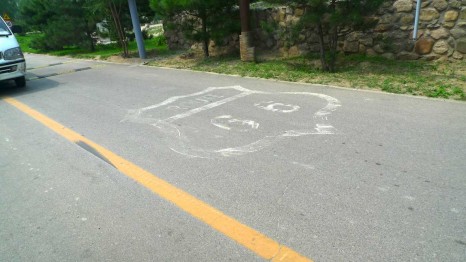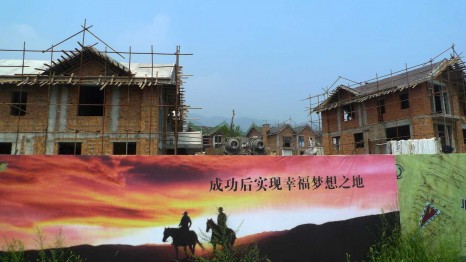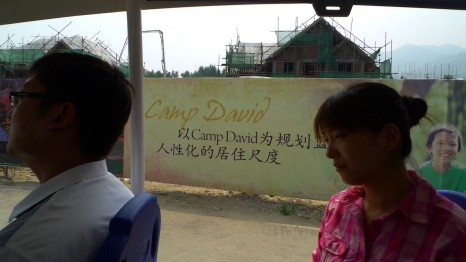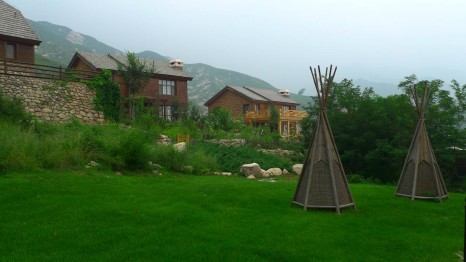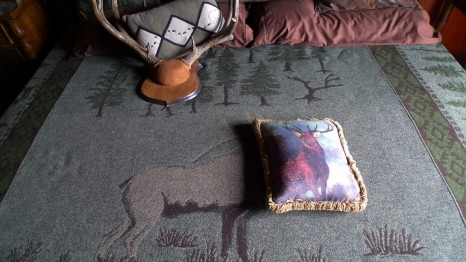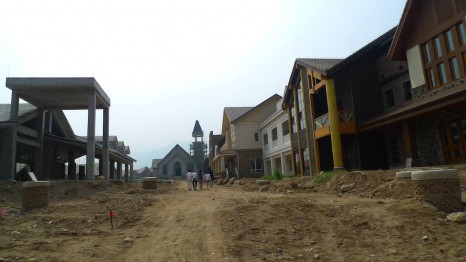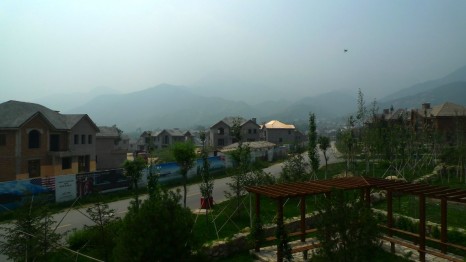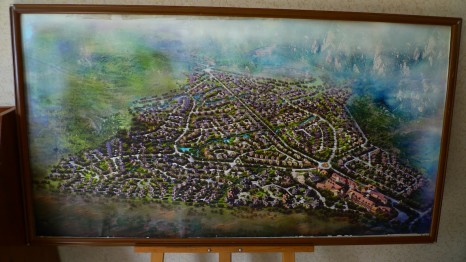Several months ago a friend working for the “Un-Named Design” section of the 2011 Gwangju Design Biennale (titled “Design is not Design is Design”) put me in touch with some of her colleagues researching paraphernalia associated with death rituals, presumably as examples of un-named design. My friend was aware of the paper objects I have been making in dialogue with the neighborhood Shouyi, so the researchers asked where they could find these shops. I sent them some images of my objects and research, as I hadn’t even taken images of the insides of the Shouyi stores. But I deliberately refrained from telling them where our neighbors’ store is (it’s directly across from us in the alleyway).
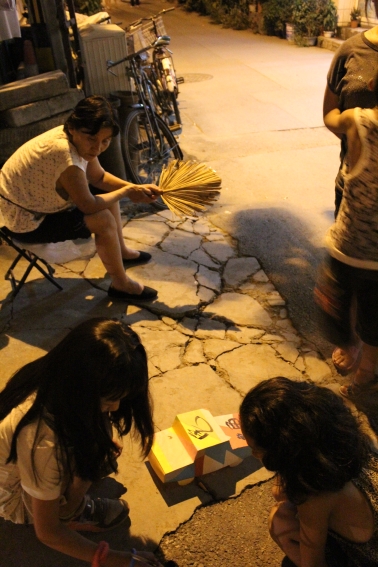
In the summer one of our turtles stopped moving. We buried its body under the shrub by the gates. 夏天的时候,我们养的四只乌龟中有一只死了,我们将它埋在门口的灌木丛里。
This sounds silly now, but in my defense, I swear it wasn’t because I wanted to be the only cultural poacher in the neighborhood. I was simply trying to remain as true as possible to the subject I am following, which from the outset of my acquaintance seemed shrouded in secrecy. When we were preparing the first Beiertiao Leaks a year ago, Xiao and I went over to ask if the Shandong-bred mother-son business team living and working there would place an advertisement free-of-charge in our small newspaper. They refused on the grounds that it was bad luck to publicize as a profession dealing in “superstition.” They didn’t want publicity and wouldn’t allow any pictures or direct mentions of their store printed. Being a sector based on spirituality and superstition, it is kept a close eye on by authorities, and we were told that the government has a monopoly on the funerary industry. Apparently, if one were to buy an urn from our neighbors, it couldn’t be buried in an official cemetery, as they aren’t officially sanctioned. We suspected part of the issue was the instability of their own personal situation. They cagily but politely answered our inquiries, though, so we prepared a short article introducing the phenomenon only to the English-speaking readership.
The title of this brief piece had the Chinese characters “寿衣“ in it though, so the day after distributing the scrappy new copies of the first edition of Beiertiao Leaks we received reprimands from some of the neighbors for even broaching the subject. It seemed from their reactions that, aside from this little shop’s ambiguous relation to the state, as an area of human activity addressing the mysteries of what happens after you die, one shouldn’t speak openly about these rituals.
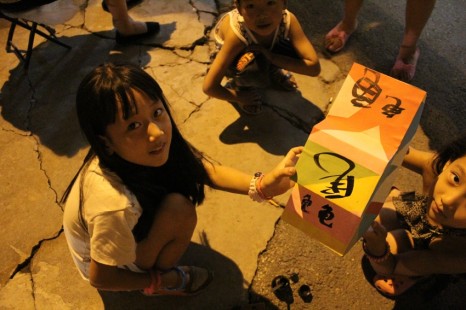
We had never given it a name, so in order to wish it well, we decided on one: �龟龟 (Gui Gui). 我们的乌龟生前没有名字,但为了祝福它,我们决定叫它龟龟。
Watching a presentation in November by Brendan McGetrick, one of the curators of “Un-Named Design,” we saw an inspiring methodology in organizing a wide range of ideas and artifacts. Toward this, there was a thoughtful attempt to broaden the definition of design to examples of rustic and simple but effective uses of everyday items, scientific innovations and even protocols of action and social situations: “a political protest manual, DNA barcodes, execution procedures, a transcontinental monetary system.” So what made these diverse examples design? McGetrick wrote: “The goal of this theme is to reframe design as a set of strategic solutions to human needs, rather than an ego-driven pursuit of subjective beauty.”
Shouyi goods draw from the design world in the most flagrant sense that McGetrick was reacting against, as they itemize the essential commodities of our lives, and more often consist of the most luxurious fetishes that our cultures share, like money, cars, fancy clothes, mobile phones, and mansions. Their production process rarely results in direct copies, of course. Neither are they really intended to function like shanzhai products, which are in a sense copies better than the original, though they often include subtle and sometimes humorous twists and references to their repurposing. A simple question of materiality determines the boxy appearance of Shouyi goods: they are made of paper and intended to be burnt. The indifference of fire determines a certain indifference of production where other definitions of design come in. The material must adequately combust, thereby expeditiously crossing from the world of the living to that of the dead—but almost anything burns. Having understood this in a peculiarly modern sense, as compared with the more elaborate offerings and sacrifices of bygone times, many people normally opt for rather indifferent forms of tribute to their deceased loved ones or ancestors. The modern sense of sacrifice is that with its democratization has come its effective desacralization and rationalization. However, the ritual of burning Shouyi goods is obviously intended more directly as sacrifice than its substitution with literature (Georges Bataille) or its resonance in all modern music forms (Jacques Attali). It fulfills its function but it must be cheap. Therefore, like all aspects of the modern world, it is conventionally mass-produced and readymade. An average full household set of the nine necessary amenities costs only 15 yuan. If money is no object, one can order the larger dollhouse-size villas or 3/4-scale plasma screens, from a catalogue of hundreds of choices, as the small shops in Beijing usually have them delivered from Hebei manufacturers on request. But logically, as money is an object, the most popular sales are bundles of extremely inflated denominations of “Hell Money,” a very good value-for-your-dollar deal.
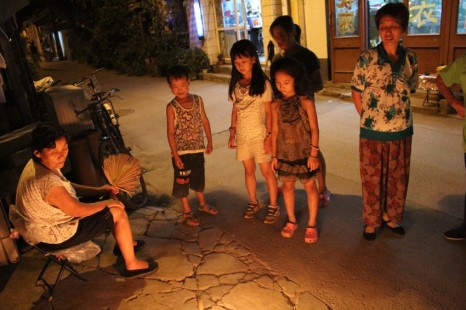
What can a turtle do with a car, they questioned. 他们在琢磨,一直乌龟要辆车做什么呢.
But why, I wondered, should this be logical? If Shouyi is about venerating the dead and trying to make their afterlives more dignified, then why are we satisfied with the most cheaply-produced replicas? Is it that the most generic commodities are the most ready stand-in for “pure exchange”? And yet if there is the allowance of kitsch (for instance, pagers and mobile phones that boast of dual-band SIM cards functioning both on Earth and in Heaven, or Renminbi with the face of a god in place of Mao Zedong) then why do we have to buy these sham-brand-name goods from dealers instead of making our own or customizing them to suit our personalities, affections and values? Does it say something about our relationships with our relatives?
With this line of questioning in mind, I produced some very basic paper objects and brought them over to the shop to see if they would accept them to sell. Turning them over, our neighbors commented on the design but confessed they wouldn’t be able to sell them. They were free to set the price and to keep the money, I assured them, while the mother asked dubiously again and again whether they needed to pay me. My only request was to report to us how people perceived them. On our insistence, they said they were willing to take a couple of them, though, just to see what would happen. In my mind, I thought perhaps that at least the sign of the object being made by hand might make a difference to someone. The shop owners said that in the unlikely event someone bought one of them, no matter the price, they were more likely to put them on their shelves and hold onto them rather than set fire to them. This was interesting but still a frustrating compromise; it neatly avoided the problematic desire for real engagement that is the intention of my work, and which determined the relative secrecy and modest scale of my project. In any case, the possibility was there: passing the doors for the next couple of weeks, I was pleased to see my colorful car on the glass counter. After some time it disappeared, though I know it was never sold. They had simply tolerated my meddling enough and couldn’t justify the use of space. We were awkward enough to never again address the topic.
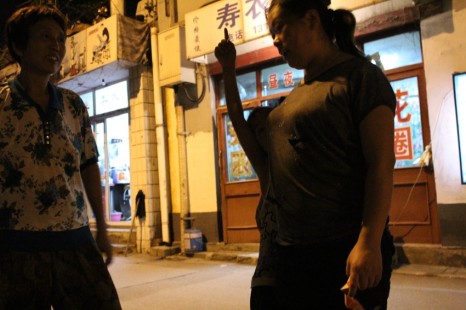
A boy was asked by his mother where Gui Gui is now, and he pointed up toward the dark sky. 一个小男孩问他妈妈,龟龟去了哪里,于是他的妈妈指向夜空.
Rituals surrounding death are a commonality among almost all peoples of the world, though the manner in which I grew up included fairly few practices comparable to Shouyi. For many, death is where religion is concentrated or re-emerges, as it is one of the only unaccounted-for parts of humans’ experience, otherwise always supposed to be understood. I remember funerals of my relatives seeming rather like any other momentous occasion, though blacker in mood. Some believe in heaven, but I don’t. In this, I may differ from other members even of my own family or those close to me (though on my mother’s side, which is Jewish and so the more distinct cultural identity, you could say there is a thoroughly secular tendency among sections of my relatives: in my uncle Alex’s words in an email, “An asteroid will hit the earth and it will all eventually end. It’s all bullshit.”). Traditions, if they can be said, fragilely, to exist in our case, do so only insofar as they punctuate our disparate lives.
In a way, this is the design of culture if not religion, hard-wired or useful enough to withstand all the dissolutions of the modern world. The gestures of a priest, the words of a rabbi or the rites of a woman burning paper money on the street are in some ways designs of community. In the latter case, perhaps it is the design that recreates in symbolic form a familial system of interdependency and debt that structures the lives of the living in China, and acknowledges its extending beyond. The custom of burning paper replicas might be seen to re-establish connections that can never be referred to exclusively as material, even as the designs of the objects themselves are periodically updated or added to.
As I am speaking from a rather uninformed perspective, it is hard to go much further into what might be anthropological, sociological or religious theories of action and belief, and it is also here where theories and beliefs splinter into seemingly contradictory positions. How can we really commune with ghosts if we sympathize with their presence in so utilitarian a manner? This question raised, am I already too late? A whole slew of understandings and misunderstandings of what is real belief underpins its approach as art, pulling in the contradictory directions of doubt and identification. After all, how can we say for sure that this intimacy desired is something actually shared with the people who burn the paper objects for their loved ones? Has the ritual itself not become something “diluted” into expected tradition? And therefore, what is the relation of individuals to their customs; as the outsider, isn’t it simply not my place to enter?
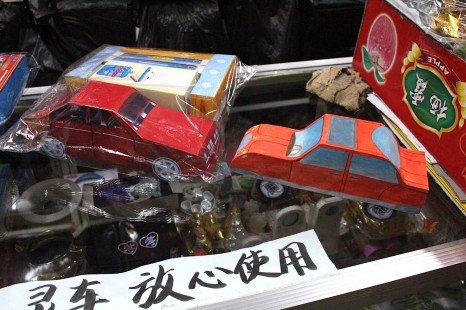
There are in fact many Shouyi shops in our neighborhood. I decided that it was time to approach one of the more “official” shops near the hospital. Like our neighbors they are open all hours, to match the contingency of schedule that moderates the ending of a life. One evening I went over with Chenchen and found that they were much more forthcoming in discussing the topic, rather than more closed as I had assumed. The woman there didn’t think there was actually a difference in the level of legitimacy of Shouyi shops, and she dismissed the idea that urns of so-called unofficial origin wouldn’t be acceptable in official graveyards. The explanation that she instead provided for the difference between the shops was that her family, made up of Beijing natives, did not come from away and had been in the business a long time, so they could be more sensitive in their counsel to local customers. The woman gave me criticisms of the objects I brought her. I returned a week later with a new version of a paper car, this time with hand-painted details, and she asked me where the other items were, the refrigerator, washing machine, wardrobe, bed, and so on. Her attitude was what finally lead me to this betrayal, to loosen my hold on the discretion I felt necessary for real engagement. Activity that operates on rather personal levels sits awkwardly when shifted to a discussion that could be called public, as I am doing now, namely for the reason that doubts arise about the genuineness of the engagement. (Are you a real believer?) This can’t be proven either way, in the end, and the future of this engagement cannot be predicted. Classifying a practice as design is a sign of the removal of belief, as one sees the ends an object is put to, its actualization “as a set of strategic solutions to human needs,” rather than as truth itself (a suspicion that recalls Vilém Flusser’s assertion: “A designer is a cunning plotter laying his traps.”) But if opening up the discussion allows us to see another perspective and to extend the idea beyond fitting in, exploiting or imposing, then that may be when this external custom is made into our own ritual. Rather than reining in spirits for instrumental ends or liquidating everything into the irony that glazes the oblivion lying behind our modern world, artwork can make moves toward becoming authentic—it cannot arrive there too hastily.
******************************
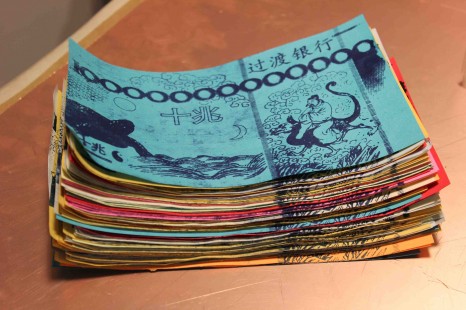
(非常感谢高源翻译的英文原版 Chinese translation of the original post in English thanks to 高源鸿!!! 谢谢!!!
几个月之前,有位在2011光州设计双年展(主题为图可图非常图)非定名设计单元工作的朋友介绍了几位她的同事给我认识。他们在对祭奠用品进行研究, 大概这些用品是他们非定名设计的研究对象。我的朋友知道,我在和附近寿衣店的邻居有交流,制作了一些纸质物件,所以她研究祭奠用品的这几个同事想知道,这些店在哪儿。我给他们发了几张我制作的纸件和研究的照片,但其实我都没有给寿衣店内部拍过照。不过,我确实故意没告诉他们这些店的具体位置(其实就在我们工作室的正对面)。
这听着有点傻,但是我想声明一下,我这么做并不是因为想独占我周边的文化资源。我只是想研究这些小店同时不影响它们的真实性。这些小店从一开始,就笼罩在一片神秘之中。一年之前,我们在准备北二条小报第一期的 时候,老萧和我特地去和问过开寿衣店的山东母子,要不要在我们的报纸上打个免费广告。两人拒绝了我们的提议,理由是做这种“迷信”的广告是不吉利的。政府 对这种迷信产业进行着严格的监管,而同时又垄断着殡葬业。比如, 从我们对门邻居店里购买的骨灰盒,是不能进入公墓的,因为我们的邻居没有官方的批准。我想,这可能和他们本身不稳定的处境有关。他们在回答问题时,彬彬有 礼而小心谨慎。所以,我们写了一篇短文,发在北二条小报上,仅向英语读者介绍这一现象。
不过,这篇短文的标题上用中文写了“寿衣”二字。所以在我们这份杂七杂八的报纸创刊号发行的第二天,就遭到了一些邻居的责怪,认为我们不应该提及这 方面的内容。从他们的反应当中我感受到的是,不仅对门寿衣店与政府的关系难以说清,连关于人们离世后的仪式也是不可轻启的话题。
11月的时候,我们看了Brendan McGetrick的演讲,他本人是“未定名设计”的馆长之一。他以让人耳目一新的方式,向我们呈现出了各种创意与作品。他运用简单质朴的日常物件,科技产品,甚至社会现象来扩展设计的定义。比如:“政治抗议手册,DNA条码,死刑执行程序,跨洲货币体系”等等。那么这些如何成为设计的范例呢?McGetrick写到:“本次展会的目的,就是对“设计”进行重新的定义。设计是满足人类需求的各种战略解决方案,不是艺术家为了标榜自我而造出的主观产物”。
祭奠用品的设计可谓是McGetrick理念的反义词。这些用品悉数列举了日常生活的所有物件,通常涵盖我们文化当中的奢侈商品,比如:钱、汽车、 高档衣服、手机和大楼。这些用品并非照搬物品原来的样子 ,也不是按照“山寨”的理念进行的。在某种程度上说,山寨好于原装产品,有的时候山寨机还会微妙而幽默地改变原机的功能。决定祭奠用品的外形的还有另外一 个实际原因:为了便于焚烧,它们是用纸做的。因为这样的最终目的,设计当中的其他元素往往不被考虑在内。制造材料一定要能够充分燃烧,这样才能尽快进入地 府——虽然几乎任何材料都是可燃的。曾几何时,人们在提供祭品的时候更加慷慨。但现在人们有着当代的理解,往往选择更普通的方式祭奠过世的爱人或祖先。 现在人人都可进行祭奠活动,所以祭奠也变得不在神圣,趋于理性。但是毕竟,相比于Georges Bataille提出的,用文字寄托哀思,或Jacques Attali倡导的,寄悲情于当代音乐,烧纸钱、烧祭物,显然还是更加直接的祭奠方式。然而这些用品必须做到能物尽其用同时价格低廉。所以,与现代社会的 其他产品一样,祭奠用品也是大规模的现成制品。一套九件的祭奠品仅售15元。如果钱不是问题的话,还可以定做娃娃屋大小的别墅,或者等离子电视。在北京的 小店里你可以在列着上百条物件的清单上订货,然后河北的制造者就会发货过来。不过,一般来说,卖的最好的还是成捆的通胀率极高的冥币,价格十分公道。
但是让我不解的是,如果祭奠用品的意义在于让死者在地府活得体面,那为什么还用最便宜的材料给他们做各种物件的复制品呢?是因为在这“纯粹的交换” 中,最普通的商品,也是最合适的替代品吗?如果可以用仿冒品的话(比如,生前死后都可使用的双SIM卡手机;印着玉皇大帝的冥币),那么为什么还要买那些 卖家的赝品,而不去自己制作一些适合自己情况和价值观的用品呢?这样不是能更好的阐释我们去已故亲人的关系吗?
带着这些想法,我自己制作了一些纸件并拿到对门的寿衣店,想知道能不能卖出去。我们的邻居并不吝惜对设计本身的评价,却坦承觉得这卖不出去。我向他 们说明,他们可以自己定价,卖出去的钱完全归他们所有,他们也不断地问是否真的不需要给我任何钱。我唯一的要求就是请他们告诉我人们的反应。在我们的坚持 下,他们同意拿几个看看。我本以为,手工制作可能对人们更有吸引力。然而店主却说,有人倒是买了一件,不管是以什么价格出售的,此人却打算留着我做的纸件 而不是用于焚烧。这对我来说有些有趣,也有些让人失望。这并不是我的预期目标,也不是我最初保密的目的。不管怎么说,我还是觉得有机会的:接下来的几周, 我路过对门,发现我的彩色小车摆在他们的玻璃柜台里。过了一段时间小车不见了,我却知道原因不是卖出去了。他们就是无法再忍受我的掺合,不想摆在柜台里 了。而我们也觉得很尴尬,不敢旧事重提。
对亡者的纪念全世界都有,而我所知的祭奠方式相较这种简单很多。对很多人来说,谈到死亡,往往会谈宗教;而不信教的人,在说到死亡的时候,也会谈谈 宗教,因为,没人谁真的知道死亡是怎样的一种体验,只能通过宗教来解释。我还记得参加过的几次亲戚的葬礼,感觉与其他重要场合没有什么特别大的区别,只是 气氛凝重些。有的人相信天堂,我并不相信。在这点上,我与很多人包括亲属朋友是不同的。(我母亲是犹太人,她的文化身份可能更明显,而我其他亲戚的观点更 集中于现世,引用我一个叔叔Alex在邮件中的原话,他说“等到陨石撞了地球,一切灰飞烟灭,一切都是浮云”)。如果说我们这个例子里,还依稀可见传统的 影子的话,那么最多也只是说,这些传统时不时的扰乱了迥然不同的生活。
从某种程度上说,对死者的纪念,是人们用一种宗教,或者文化的方式,对抗着对于当代社会(流于物质)的失望,这种设计,可以说是存在于我们的内心深 处根深蒂固的本能,或至少是,一种行之有效的对抗方式。牧师的动作,犹太拉比的语言或者在街边烧纸钱妇女的做法在一定意义上都是他们所在的环境的设计。而 对于烧纸钱的妇女来说,这种设计其实是以象征的方式,重新构建了中国传统家庭相互依靠的体系,而让这些理念不因生命的终止而结束。但其实,即使焚烧的物件 可能会变,这种习俗仍是在试图同精神世界建立一种连接,虽然表现形式是物质的,但实质并不全是。
我是站在一个不了解内情的人的角度上发表的观点,很难深入从人类学、社会学或宗教理论上进行分析。也就是在此,理论和信仰似乎分裂成了自相矛盾的境 地。如果我们对待鬼魂的方式如此功利,我们如何能够真正进入灵魂的世界呢?带着这样的问题,我不禁自忖,是否现在已为时太晚?围绕真正的信仰问题,各种阐 释与误解将我们对待灵魂的方式定调为艺术,但何为真相,何为误解,我们的路程在发现与怀疑的相反方向上,渐行渐远。毕竟,扪心自问,我们能说,扫墓者在祭 奠先人时,所希望获得的,也是我们所期待的这种近距离的心灵体验吗?这些纪念本身是否已经稀释成了一种约定俗成的仪式?那么,个人与习俗的真正关系又是什 么呢,我作为外来者是否就本不应该介入呢?
我们周边其实有很多家寿衣店。我决定去接触临近医院的一家更为“正规”的寿衣店。和我家附近的几家寿衣店差不多,这家店也是24小时开放的。毕竟, 当生命走到尽头的时候,说不好什么时候,寿衣就派上用场了。一个晚上,我和陈陈一起去了这家寿衣店,他们比我想象的更愿意谈这个话题,我本以为他们会对此 缄默无言。与我交谈的女士不认为寿衣店有任何不同,她也不认为所谓的私人处购买骨灰盒不可进入公墓的说法是真的。她给出的理由是,我邻居不像他们是本地 人,入行时间短,所以在与当地顾客交谈时更为敏感。这位女士还对我拿去的纸件做出了批评意见。一个星期后我拿着改进过的纸件又去找她,这次纸件上有了手绘 的细节。她问我,其他的像冰箱、洗衣机、衣柜床的物件在什么地方。正是她的态度导致了我的变节,让我觉得,之前的谨慎低调都是不必要的。祭奠,本是很个人 的行为;但若仅仅因为质疑这一活动的纯粹性,便以此为题,公开讨论,是会让人感觉,多少有些尴尬。(你真相信灵魂吗?)说实话,对于这一精神世界的论断, 我们无可稽考;而未来人们将以何种方式祭奠先人,我们也不得而知。我们把一种行为冠以“设计”之名的那一刻,其实就已经表明,这已不再是种信仰。因为,我 们看到的,不再是真相,而是某个具体的物件,被赋予了具体的用途,被视作为满足人类需求而设计的一整套战略解决方案。这不禁让我想起了Vilem Flusser的名言:“设计者都是攻于心计,巧设陷阱的算计者。但如果通过讨论,我们可以获得另外一个视角,学会在思考的时候,不只局限于融合、利用、 或强行引入某种文化元素,那么,也许在这时,我们可以说,自己真正实现了外国习俗与自身艺术的水乳交融。艺术作品不是人类征服精神世界的工具;不是对逝者 简单粗暴的讽刺;相反,艺术作品可以是纯粹的;但真正的艺术来不得半点匆忙。
(originally posted on the HomeShop blog, 28/11/2011)
